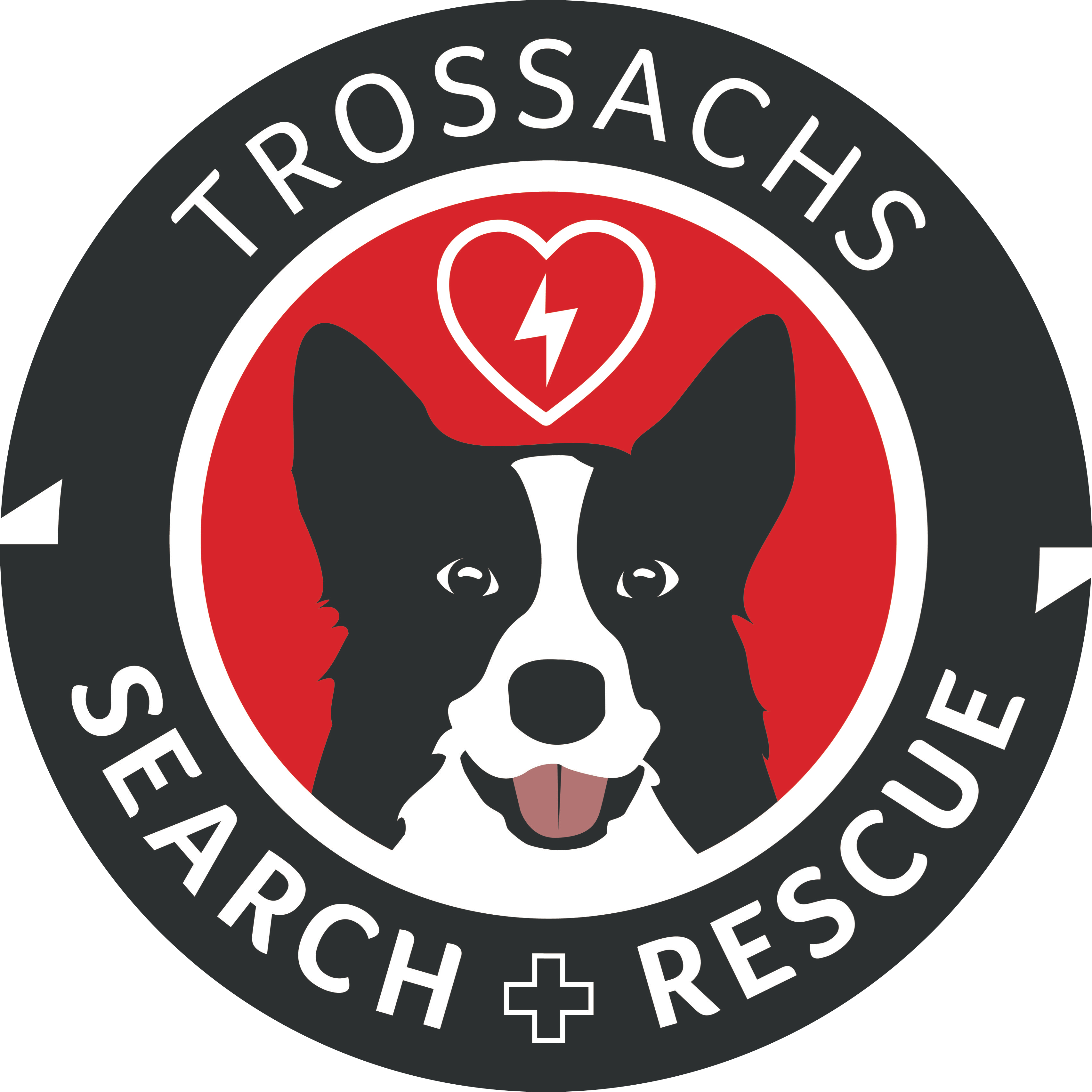The time taken to train a search dog to the high standard that the emergency services expect, varies from dog to dog, and handler to handler. Some of our dogs master the art of “hide and seek” pretty quickly, whilst others have taken a wee bit longer – not all dogs pass their assessment on their first attempt.
Many search dogs have different capabilities and skills depending on the terrain and situation they are trained in. TSAR’s training and qualifying skills include: rubble piles, collapsed structures, darkened rooms, immediate areas, open rural woodland, farmland, hill areas and busy city centre / heavily populated areas.
Non-Scent Specific Dogs
- Open area – this is lowland and rural environments where a person may have wandered off into or fallen and sustained an injury. This could be fields, coastline, river bank or woodland searches.
- Urban – this is searching in park areas or in areas where there are derelict buildings.
- Collapsed structure – This is search buildings that have collapsed or similar environments, in this case the dog rarely comes into contact with the casualty but will show an area of interest to be investigated by the fire service.
These dogs are non-scent specific due to the nature of their work and are trained to find the person in an environment where there may be many articles of the people we are looking for which will slow down the process if they are trained to work with a specific scent.
Scent-Specific Trailing Dogs
- Dogs can work in open rural woodland, farmland, hill areas, also busy city centres and heavily populated areas.
- They use an article of personal clothing from the missing person to gather their scent, they can also take scent from vehicles or other items belonging to the missing person.
- They follow the missing persons scent ONLY and discriminate away from all other scents on a search; this makes them extremely useful for providing a direction of travel of the missing person which can often help lead to a quicker outcome to a search.
- The dog works in a harness and long-line held by the handler and both air scents and ground scents to locate their missing person.
- The dog also gives a start of scent indication of the missing person to their handler, which can help identify a commencement point for a search.
All teams used by the professional emergency services must satisfy those services of their capabilities – Trossachs Search and Rescue Team are no exception, and we are authorised to be called out by both Police Scotland and Scottish Fire and Rescue Service.
The Team Search & Rescue dogs (SAR) are subject to external assessment to get onto our call out list. Within Trossachs Search & Rescue’s lifetime (since 1998), the external assessors have come from a wide variety of organisations including Police dog handlers, Fire Service dog handlers, and we have used NSARDA assessors as well as dog handlers from many other search dog organisations throughout the UK.
Our search dogs are assessed to National Urban Search and Rescue standards as laid down by the National Urban Search and Rescue Dog Group. Dogs are assessed initially by 4 experienced SAR dog handlers: 2 from TSART and 2 from other organisations. The initial assessment lasts for 1 year, the dogs are then reassessed after those 12 months and if they pass, they are then qualified for 2 years, from that point on the dogs are reassessed every 2 years.
During searches, all hides are blind (handler does not know where they are) and each team must pass all elements before becoming qualified. These are the standards we work with along with a fire service understanding of inner and outer cordons, Coastguard procedures, police protocol and Scottish Ambulance Service operational systems – only qualified search dogs within their training remit, can attend searches of any description and/or terrain.
The standards we follow are substantially based upon those set by the National Urban Search and Rescue Dog Group in 2004 which were agreed by the following organisations:
• Her Majesty’s Fire Service Inspectorate (England)
• Association of Chief Police Officers
• Association of Chief Police Officers (Scotland)
• United Kingdom Fire Service Search and Rescue Team
• Trossachs Search and Rescue Team
• Disaster Dog Group
• Emergency Search Dogs
• British International Rescue and Search Dogs
• Lowland Search Dogs (Southern)
• CANIS
And thereafter adopted and updated by the National Urban Search and Rescue Dog Group (Scotland) in 2011
What all Teams throughout the country do have in common is that we all want to find the people we are looking for as quickly and efficiently as possible. The Police and Fire Service have many search tools at their disposal, not just search dogs, and will use the services best placed to find the missing person.
Here are a few places where Trossachs Search & Rescue Team have been tasked to search:
- Stockline factory collapse – Glasgow
- Glen Ogle landslides
- Search for missing fishermen – Portlethen, Western Isles, St Cyrus
- Search for Simon McMillan – South Uist
- Search for murder victim Joanne Nelson – Humberside
- Search for murder victim Suzanne Pilley – Arrochar
- Country mansion collapse – Lathallan, Polmont
- Riverside searches (various)
- House collapse – Callander
- Clutha pub, Helicopter crash – Glasgow
- Country mansion collapse – Stirling
- Search for missing persons – Scotlandwide
With this experience and credentials, qualified dogs and handlers are called out regularly by Police Scotland and Scottish Fire and Rescue Service to assist with their services.

